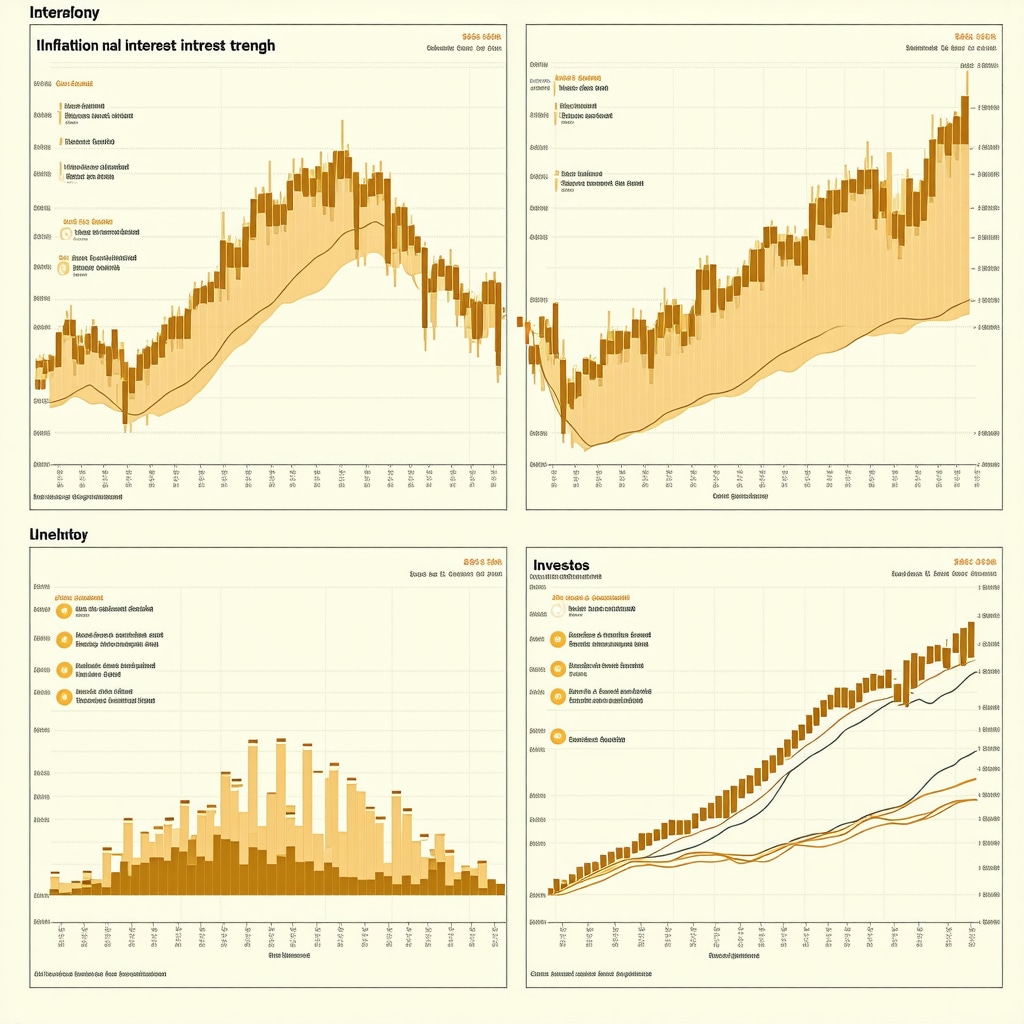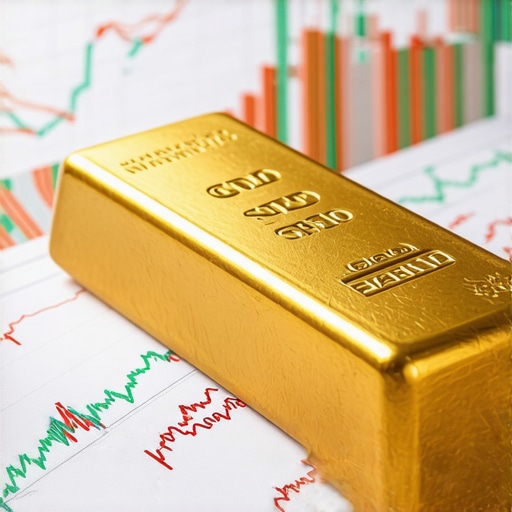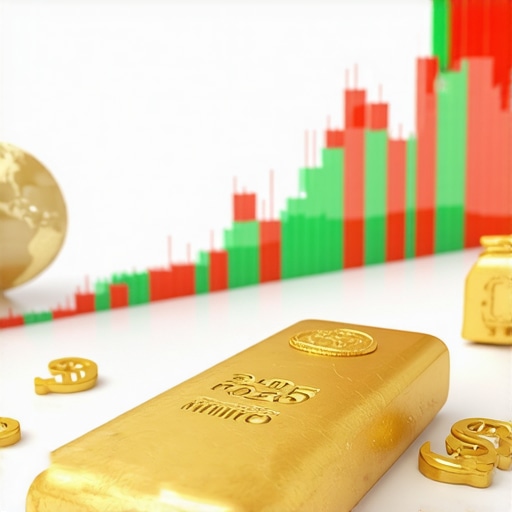When Gold Talks, Do You Listen?
Ah, gold — that gleaming, age-old harbinger of wealth and security. But if you think gold is just a shiny relic for jewelry and royal coffers, think again. Its global demand is a complex dance, choreographed by economic shifts, geopolitical tremors, and cultural rhythms. As someone who’s tracked markets through booms and busts, I find the pulse of gold demand a fascinating storyteller, revealing much about where prices might be headed next.
The Glittering Puzzle: What’s Driving Gold Demand Worldwide?
First off, there’s the classic trio: jewelry, investment, and central bank purchases. Jewelry accounts for a hefty slice of global demand, especially in countries like India and China, where cultural affinity for gold runs deep. But it’s the investment demand — from ETFs, gold bars, and coins — that often acts as the market’s barometer of fear and optimism. Central banks, meanwhile, have become surprisingly aggressive buyers themselves, reshaping market dynamics in ways many don’t fully appreciate.
Why Do Central Banks Hoard Gold Like Dragons Sitting on Treasure?
This question might sound whimsical, but it’s a real driver behind recent price movements. Central banks are diversifying reserves, hedging against currency risks, and signaling confidence or caution. Their strategic gold buys can tighten supply and spark price rallies, making their actions a critical watchpoint for investors. For a deep dive into how central bank gold purchases affect price volatility, I highly recommend this insightful analysis.
Gold and Geopolitics: A Love-Hate Relationship
Gold’s price often reacts like a canary in the coal mine to geopolitical upheavals. From trade wars to inflation fears, these events can send investors scrambling for a safe haven. The COVID-19 pandemic was a textbook example, catapulting gold prices as uncertainty soared. But it’s not always predictable — sometimes markets shrug off crises, other times they react with gusto. This makes understanding the nuanced demand trends essential for savvy investors.
Can We Really Predict Gold Prices by Watching Demand Trends?
Is Gold Demand the Crystal Ball Investors Have Been Waiting For?
In theory, yes: tracking shifts in demand across sectors and regions can reveal future price directions. But the market is a living beast, influenced by macroeconomic policies, currency fluctuations, and even investor psychology. The trick is to blend data with a seasoned eye for the subtle signals. For those ready to sharpen their forecasting skills, exploring how gold demand trends impact prices in 2025 can be a game-changer.
As a final nudge, I invite you, dear reader, to dive into these insights and share your own thoughts. Are you bullish on gold’s future, or do you see clouds on the horizon? Your perspective enriches the dialogue.
For a comprehensive view, the World Gold Council’s market reports remain an authoritative resource, offering transparent, data-driven insights into the ever-evolving gold landscape (World Gold Council Demand Trends).
Unpacking Regional Nuances in Gold Demand
While global trends shed light on the broad strokes of gold demand, the devil is in the regional details. For instance, India’s monsoon season and festival calendar heavily influence jewelry demand cycles, reflecting cultural nuances that can temporarily boost prices. Meanwhile, in China, urbanization and rising incomes spur a growing appetite for both physical gold and digital gold investments, such as gold ETFs. Understanding these dynamics is crucial for investors who want to anticipate demand-driven price movements rather than merely react to them.
What Role Does Technological Innovation Play in Shaping Gold Investment?
Emerging technologies have introduced novel avenues for gold investment. Blockchain-based gold tokens and digital vaulting services offer fractional ownership and liquidity unimaginable a decade ago. These innovations democratize access but also add complexity to demand forecasting. How might these technologies reshape long-term demand? Will they attract younger demographics traditionally less inclined toward physical gold? These are pressing questions for analysts and investors alike.
For a comprehensive exploration of how technology intersects with gold investment, the Investopedia analysis on blockchain’s impact on gold markets offers authoritative insights that blend technical depth with market relevance.
Central Bank Strategies: Beyond Hoarding to Strategic Positioning
Central banks are no longer passive custodians of gold; they actively deploy gold reserves as tools of monetary policy and geopolitical signaling. Recent purchase patterns suggest a strategic diversification away from US dollar dominance, aiming to buffer against currency volatility and sanctions risks. This shift underscores a more intricate relationship between gold demand and international diplomacy, where gold serves as both an economic asset and a geopolitical chess piece.
Investment Strategies Tailored to 2025’s Gold Market Landscape
Given these multifaceted demand drivers, investors must craft nuanced strategies. Diversification across physical gold, ETFs, and mining stocks can balance liquidity, growth potential, and inflation hedging. Additionally, timing entry points around known demand catalysts — such as central bank disclosures or festival seasons — can enhance returns.
For practical guidance, explore our detailed top gold investment strategies for 2025 to align your portfolio with anticipated market movements.
How Can Investors Navigate the Complex Web of Gold Demand Drivers?
Disentangling the intricate and sometimes opaque factors influencing gold demand requires a blend of data literacy and market intuition. Investors should continuously monitor central bank reports, geopolitical developments, and emerging technologies while contextualizing these within cultural and economic frameworks. Staying informed through authoritative sources, such as the World Gold Council, combined with strategic diversification, remains the cornerstone of successful gold investing.
If you’ve found these insights valuable, share this article with fellow investors or comment below with your perspectives on gold’s evolving role in global finance.
Deciphering the Subtle Signals: How Macro Trends Intricately Influence Gold Demand
Gold’s allure is far from static; it morphs with the intricate weave of macroeconomic trends. Inflation expectations, real interest rates, and currency fluctuations form a triad that subtly but powerfully orchestrate demand shifts. For instance, rising inflation often ignites gold’s appeal as a hedge, yet when real interest rates climb, the opportunity cost of holding gold increases, dampening demand. This tug-of-war creates a nuanced landscape where investors must balance conflicting signals.
Moreover, currency dynamics, especially the US dollar’s strength, play a pivotal role. A stronger dollar typically depresses gold prices as it raises the cost for holders of other currencies, but this relationship is not absolute. In times of geopolitical tension or systemic risk, gold’s safe-haven status can override currency effects, driving demand irrespective of dollar movements.
How Do Inflation Expectations and Real Interest Rates Converge to Shape Gold’s Demand Trajectory?
Understanding the interplay between inflation expectations and real interest rates demands a sophisticated analytical lens. Inflation anticipation increases the allure of gold, perceived as a store of value immune to currency debasement. However, if central banks respond with aggressive rate hikes, pushing real yields higher, the relative attractiveness of non-yielding gold diminishes. This creates a complex feedback loop where investor sentiment and central bank policies dynamically influence demand.
According to research published in the Journal of International Money and Finance, the nuanced interactions between these variables can explain much of the short to medium-term volatility in gold prices, emphasizing the need for investors to monitor both economic data and policy signals concurrently.
Gold’s Technological Frontier: The Rise of Digital Gold and Its Demand Implications
The gold investment landscape is undergoing a technological renaissance. Blockchain-enabled gold tokens, digital gold savings platforms, and fractional ownership models are democratizing access beyond traditional buyers. This digital transformation injects fresh demand vectors but also complicates traditional supply-demand analytics.
Digital gold products can attract younger, tech-savvy investors who might have previously viewed gold as archaic or inaccessible. This demographic shift could expand overall demand, but it also introduces volatility as these investors often exhibit different behavioral patterns than traditional holders.
What Are the Risks and Rewards of Digital Gold Investment Platforms on Long-Term Demand Stability?
While digital platforms enhance liquidity and accessibility, they carry systemic risks related to regulatory uncertainty and custodial trust. The possibility of platform failure or cyber threats may intermittently suppress demand or trigger rapid sell-offs. Conversely, their widespread adoption could stabilize demand by creating continuous, low-barrier entry points for global investors.
Investors keen on integrating digital gold should conduct rigorous due diligence and balance their portfolios with physical gold holdings to hedge against technological disruptions.
Geopolitical Chessboard: Gold as a Strategic Asset Amid Rising Global Tensions
Gold’s role as a geopolitical instrument is evolving. Beyond being a refuge during crises, it’s increasingly a strategic asset leveraged by nations to circumvent sanctions and preserve economic sovereignty. The recent uptick in gold repatriation efforts by various central banks highlights this trend.
This geopolitical dimension adds layers of complexity to demand forecasting, as gold flows may no longer be driven purely by market economics but by diplomatic maneuvers and shifting alliances.
For investors, recognizing these subtleties is essential. Monitoring geopolitical developments and correlating them with central bank disclosures can provide early signals of demand spikes or contractions.
Can Gold Demand Trends Predict Geopolitical Realignments?
While causality is challenging to establish definitively, patterns in gold accumulation and movement often precede or coincide with geopolitical shifts. Analysts at the Council on Foreign Relations note that gold’s strategic utility often mirrors a nation’s foreign policy priorities, making demand trends a potential barometer for emerging geopolitical fault lines.
For the astute investor, integrating geopolitical intelligence with traditional market analysis creates a more holistic approach to anticipating gold demand.
As this exploration unfolds, stay tuned for deeper dives into behavioral economics affecting gold investment sentiment and the impact of emerging market consumption patterns. Your engagement and insights are invaluable—feel free to share your perspectives and questions to enrich this ongoing discourse.
Decoding the Intricate Dance Between Macroeconomics and Gold Demand
The gold market’s heartbeat is influenced by a labyrinth of macroeconomic forces that investors must adeptly navigate. Inflation trajectories, real interest rate fluctuations, and currency strength collectively sculpt the contours of gold demand in subtle yet profound ways. While elevated inflation often amplifies gold’s magnetism as a hedge, rising real yields triggered by central bank policies can temper this allure by increasing the opportunity cost of holding non-yielding assets like gold. This delicate balancing act demands investors cultivate a nuanced understanding of economic indicators and policy directions.
How Can Sophisticated Investors Harness Inflation and Real Yield Dynamics to Forecast Gold Demand?
Cracking this code involves synthesizing inflation expectations with central bank responses. When inflation forecasts surge, gold traditionally shines as a refuge against purchasing power erosion. However, if central banks counter with aggressive rate hikes, real interest rates climb, making bonds and other yield-bearing assets more attractive than gold. This inverse relationship complicates the demand outlook, requiring investors to monitor not just headline inflation but also the trajectory of real yields. For a rigorous analysis, the National Bureau of Economic Research’s working paper on gold and macroeconomic uncertainty offers empirical insights into these interactions and their implications for price volatility.
Additionally, currency fluctuations, particularly the US dollar’s strength, play a pivotal role. A robust dollar typically dampens gold prices by raising costs for foreign buyers, yet geopolitical unrest can override this effect, propelling gold demand irrespective of currency trends. Recognizing these layered dynamics is essential for those aiming to anticipate market shifts rather than react belatedly.
Emerging Behavioral Economics Insights: Investor Psychology Meets Gold Demand
Beyond fundamental metrics, investor sentiment and behavioral patterns increasingly color gold demand. The psychological tug-of-war between fear and greed, coupled with herd dynamics, can precipitate demand spikes or sell-offs disconnected from traditional valuations. This phenomenon underscores the necessity for investors to incorporate behavioral economic frameworks alongside quantitative data when crafting strategies.
Can Behavioral Signals Amplify Predictive Accuracy for Gold Demand Trends?
Evidence suggests that integrating sentiment indicators—like volatility indices, search trends, and social media momentum—with conventional economic data enhances forecasting precision. A study published in the Journal of Behavioral Finance illustrates how sentiment-driven models better capture short-term demand surges, especially during periods of heightened uncertainty. By calibrating strategies to these psychological cues, investors can gain an edge in navigating volatile gold markets.
For readers intrigued by the fusion of psychology and market mechanics, our exploration of how gold demand trends impact prices in 2025 offers valuable perspectives that marry data-driven analysis with behavioral insights.
Strategic Adaptation: Leveraging Advanced Gold Investment Techniques Amid Market Complexity
In this evolving landscape, traditional buy-and-hold approaches may no longer suffice. Advanced investors are turning to diversified portfolios incorporating physical gold, gold ETFs, mining equities, and even digital gold assets to mitigate risks and exploit emerging opportunities. Timing remains critical—aligning entries and exits with central bank announcements, geopolitical developments, and seasonal demand cycles enhances returns and reduces exposure to volatility.
To delve deeper into these sophisticated strategies, consider our comprehensive guide on top gold investment strategies for 2025, designed to equip investors with actionable tactics tailored for the current market milieu.
As we continue to chart gold’s multifaceted journey through economic, psychological, and geopolitical terrain, your insights and experiences remain invaluable. Share your thoughts and join the conversation—how are you adapting your gold investment approach to these complex demand drivers?

Expert Insights & Advanced Considerations
Gold Demand Reflects a Complex Interplay of Macroeconomic and Behavioral Factors
Beyond traditional supply-demand metrics, gold’s demand is intricately tied to macroeconomic indicators like inflation expectations and real interest rates, and to the more elusive realm of investor psychology. Integrating these dimensions helps decode subtle demand shifts that pure quantitative analysis might miss. For instance, sentiment-driven surges often precede or amplify price moves, making behavioral cues an indispensable part of forecasting.
Central Banks Are Strategic Players, Not Just Passive Holders
Their gold acquisitions signal more than reserve diversification; they reflect geopolitical strategies and monetary policy hedges. Analyzing central bank purchase patterns, such as those detailed in top central bank gold purchases impacting 2025 market trends, reveals how their moves can tighten supply and catalyze price rallies, necessitating close monitoring for timely investment decisions.
Technological Innovations Are Reshaping Gold Investment Demand
Digital gold assets, blockchain-based tokens, and fractional ownership platforms are democratizing access and attracting new demographics, especially younger investors. This evolution creates new demand vectors but also introduces volatility and regulatory uncertainty. Investors should consider blending traditional physical gold holdings with digital assets to balance liquidity and risk.
Regional and Cultural Nuances Remain Vital in Interpreting Gold Demand
Understanding localized factors—like India’s festival-driven jewelry demand or China’s urbanization-fueled investment appetite—is pivotal. These nuances can create seasonal demand spikes or sustained growth trends, offering tactical entry points and portfolio diversification opportunities. For detailed analysis, see understanding gold demand trends causes and effects 2025.
Strategic Diversification Across Gold Investment Vehicles Enhances Resilience
Given market complexity, layering portfolios with physical gold, ETFs, mining stocks, and digital gold products can optimize risk-return profiles. Timing these allocations around central bank disclosures, geopolitical events, and economic cycles—guided by resources like top gold investment strategies for 2025—positions investors to capitalize on demand-driven trends.
Curated Expert Resources
World Gold Council Market Reports: Authoritative, data-rich analyses of global gold demand and supply trends, essential for grounding investment strategies in verified facts (World Gold Council Demand Trends).
National Bureau of Economic Research (NBER) Working Papers: Empirical research exploring gold’s interactions with macroeconomic uncertainty and real yields, invaluable for advanced economic modeling (Gold and Macroeconomic Uncertainty).
Council on Foreign Relations (CFR): Insightful geopolitical analyses highlighting how gold accumulation mirrors global diplomatic shifts, aiding in geopolitical risk assessment (Council on Foreign Relations).
Investopedia’s Blockchain and Gold Market Analysis: Comprehensive exploration of how blockchain innovations disrupt and expand gold investment options (Blockchain’s Impact on Gold Markets).
Journal of Behavioral Finance: Research articles that merge behavioral insights with market data to enhance predictive models for gold demand surges (Behavioral Finance Journal).
Final Expert Perspective
Gold demand trends in 2025 unfold as a multifaceted narrative shaped by macroeconomics, geopolitics, technology, and human psychology. Recognizing gold not merely as a commodity but as a strategic asset and a reflection of global undercurrents offers the discerning investor a critical edge. By synthesizing data-driven insights with nuanced behavioral and geopolitical awareness, one can anticipate market inflections more adeptly and craft resilient, adaptive gold investment strategies. I encourage you to deepen your expertise through the linked resources and to consider how these advanced insights might refine your own approach to gold investing. Engage with the evolving dialogue—your informed perspective enriches this dynamic field and sharpens collective understanding.










